Towards a Big History Model for Italian Schools:
The Convergence of Knowledge from Many Disciplines
| Correspondence | Codetta Raiteri, Adalberto et al, adalberto@codetta.it Citation | Codetta Raiteri, A et al. (2018) Towards a Big History Model for Italian Schools: The Convergence of Knowledge from Many Disciplines. Journal of Big History, III(1); 33 - 49. DOI http://dx.doi.org/10.22339/jbh.v3i1.3121 |
Abstract
To quote the psychologist Jerome Bruner, “Schooling is only one small part of how culture inducts the young into its canonical ways.” This “small part” has become much smaller in recent decades. In fact, scholastic curriculum has embraced only a small part of the enormous and complex changes that scientific and technological research has generated in everyday life and in the way people view the world. A new culture is now spreading through a multiplicity of media forms that scholastic institutions have struggled to catch on to and understand. The formation of global citizens is an emerging problem. OPPI is a small teacher training institute that for more than 50 years, in cooperation with schools and universities, has been keeping teachers aware that technological innovations are changing people’s consciousness and that education must adapt to these changes. OPPI has identified Big History as an important means to adapt scholastic instruction to youths’ consciousness and has begun to study how to implement it. Its activities begin with a questionnaire investigating the spontaneous ideas that students have acquired about the universe, not only from previous school studies, but also from social networks, the media, and their family environment. Discussion of this questionnaire is the main topic of this article. The second topic concerns the presentation of an intervention model, which is planned for students ages 16–18 and their teachers.
Scientific and technological advances have been able to curb, in much of the world, problems that have weighed heavily on human life up until the last century: famine, epidemics, lawlessness, and our relationship with death (Harari 2015). Yet the people who benefit most from this new condition are increasingly concerned about their future, and many consider the networked world produced by the development of sciences and technologies to be a danger. Indeed, the speed of this development is completely new in human history. By the middle of the century, a meticulous study of the technological advances in the history of mankind had already been published (Lilley 1946). The author examined the tools used by humankind. By the Old Stone Age they were equipped with “axes, knives, saws, spokeshaves, and scrapers of chipped stone, mallets, awls and piercing tools, needles of ivory, spears and harpoons.They also had tools for making tools.” He notes that in the “Mesolithic (Middle Stone)” Age they used adzes,gouges, and chisels to produce canoes and paddles.Lilley thus retraces the long path of inventions up to his day, assigning each a score based on their social impact. Thus he constructs a curve that he calls the “relative invention rate index,” shown in figure 1.
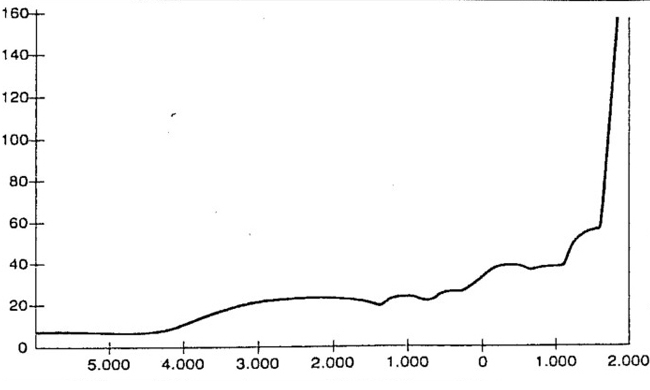
This quantitatively documents the enormous growth of inventions that began with the industrial revolution. It is interesting to note that in 1966 Lilley edited a second edition of his book, casting doubt on a quantitative analysis of the innovations:“The extensionof my relative invention rate index to the post-war period would have presented formidable difficulties”! In those same years, to understand Lilley’s difficulties, innovations and amazing discoveries took place one after the other and touched every field of knowledge: in 1953, Rosalind Franklin, James Watson, Francis Crick, and Maurice Wilkins had discovered DNA,and all the consequences of that discovery were developing; in 1957, M. and G. Burbidge, William Fowler, and Fred Hoyle had documented the role of stars in the formation of all the atoms in the Mendeleev table; in 1962, Harry Hess had formulated the theory of Sea Floor Spreading, and in 1965 Tuzo Wilson’s discoveries about transform faults and hot spots had led to the birth of Plate Tectonics. In 1969, a few years after the publication of the second edition of Lilley’s book, Neil Armstrong and Buzz Aldrin would set foot on the moon, and in 1971, Ted Hoff, Federico Faggi, and Stan Mazor would build the first microprocessor. Conditions were being created that would lead Lilley’s index of inventions, if calculated, to enormous values, growing exponentially year after year. It’s not surprising that this index resembles, down to the details, the population, shown in figure 2..
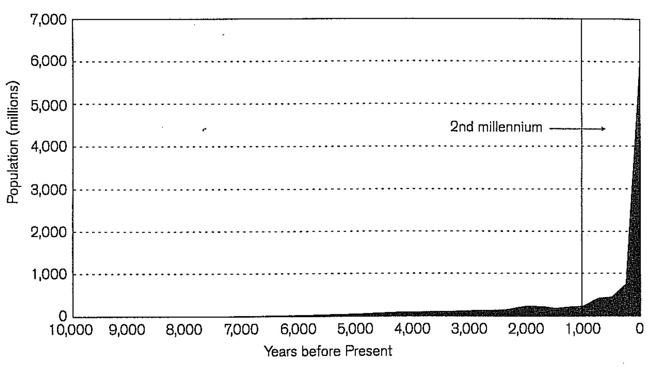
The link between technological development andpopulation growth has been extensively studied since Lilley’s time (Meadow 1973), and we know that the “rapid and sustained population growth must imply an acceleration in rates of innovation” (Christian 2005, 352). Let us now examine the equally new and dramatic problems that technological development poses to institutions and especially to those dedicated to the reproduction of knowledge
For some time we have been aware that the devicesinvented by humankind in their history, from the axe to the mobile phone, are prostheses for human organsthat modify their skills and perceptions (McLuhan 1964). Just as traditional prostheses replace diseased body parts, all the devices available to humans weaken the organs that they amplify. Mechanical tools weaken the use of muscular strength; calculators, calculation skills; media, personal relationships. The devices that increasingly crowd the human environment then change the behaviors that characterize social life. The collective consciousness (that is, the set of representations, norms, and values shared by the members of a society) also changes as the tools, the machines, and the available media change. Institutions are adapting to the evolution of the collective consciousness with a growing delay. This problem is emerging strongly in all institutions, including scholastic ones (Reguzzoni 2010). Assuming that the complexity of social institutions grows like the invention index, one could make a mathematical model that measures the delay with which institutions adapt to the changes brought about by new inventions. One could thus calculate the evolution of the distance between social institutions and the collective consciousness over time. However, today an extrapolation from Lilley’s curve, whose last significant point refers to 1943 (atomic energy), would probably be arbitrary. For us it is enough to know that, considering the exponential trend of this evolution, the delay with which institutions adapt to the changes brought about by technological development grows year after year with respect to the material needs and to the consciousness of contemporary humankind. In the globalized world, we see every day the inadequacy of countries founded on the concept of nation affirmed at the time of the French revolution. The institutions built on this concept have increasing difficulties adapting to new needs such as mobility or satisfying old ones such as social safety. More generally they fail to address and manage global problems such as climate change.
We will limit our discussion to educational institutions, to places where in modern times young people are taught to share information and symbols and practice collective learning, “so the knowledge and skills can accumulate non-genetically from generation to generation, and each individual has access to the stored knowledge of many previous generations” (Christian 2004, 146). In a globalized world, educational institutions face the challenge of the iceberg of cultures (Katan 1999, 29) and the global ICT (information and communication technologies) network. Collective learning is a fundamental characteristic of our species, and our survival relies on its effectiveness. There is an enormous imbalance between investments in communication technologies and investments in making sure that all young people, not only the elite, are able to use those technologies consciously. The disinterest displayed by governments as well as the public in this imbalance is truly concerning. “Ultimately, despite a rapid growth in education and Internet access for much of the world, most people on our planet are still disconnected from global platforms of knowledge sharing. Even amongst those two billion that are now online, a significant proportion of those that are connected are still left out of global networks, debates and conversations. Digital divisions cannot be simply bridged through connections and open platforms, and much more work needs to be done to overcome inequalities in visibility, voice and power in an increasingly networked world. In other words, while connectivity is clearly a pre-requisite for participation in 21st century platforms of knowledge sharing and participation, connectivity and access are by no means a determinant of knowledge access, creation and sharing” (Graham 2014). In schools, the informed use of ICT requires interdisciplinary approaches that challenge the traditional forms of scholastic transmission of knowledge. “In education the conventional division of the curriculum into subjects is already as outdated as the medieval trivium and quadrivium after the Renaissance. Any subject taken in depth at once relates to other subjects. Arithmetic in grade three or nine, when taught in terms of number theory, symbolic logic, and cultural history, ceases to be mere practice in problems. Continued in their present patterns of fragmented unrelation, our school curricula will insure a citizenry unable to understand the cybernated world in which they live” (McLuhan 1964, 347). For more than 50 years there has been awareness of the inadequacy of school curricula for the consciousness of the younger generation, and for some time educational research has made significant indications of renewal (Bruner 1960, 1996; Morin 1999). They should have been implemented some time ago, but the widespread lack of interest in this problem has not allowed for the formulation of projects of adequate scale. The indications of renewal are collected and tested only locally when favorable circumstances are achieved. Overall, educational institutions are losing the role of the integration and reworking of cultures gained from distant generations with those of recent generations. These are chaotically transmitted through the multiplicity of media, and young people try to interpret them more often than not without the help of the school system. Uncertainty and worries about the future, which in the countries most benefiting from technological innovations also manifest themselves politically, can also be attributed to the inability of the educational institutions to culturally prepare young people to understand and use them consciously.
Big History for an Agenda of Global CitizenshipTo help schools adapt to the cultural changes brought about by academic and industrial research, OPPI, as a teacher training organization, plays a role as an interface between research and teaching (Codetta and Peroni 1998). In this role, they identified the Big History movement as a very important resource for promoting innovation in schools. “Big History can be the basis for a new understanding in today’s global era, where change is exceptionally fast. Such macro studies can help solve global problems by supplying information for an agenda of global citizenship” (Kim 2016, 31). This new form of citizenship is promoted by sharing with young people the global networks through which the transmission of much knowledge is carried out chaotically today. If schools were able to recognize and appreciate the role of many forms of media, they could focus only partly on the direct transmission of knowledge. They could become the center of a reworking of and critical reflection on the direction taken by new educational agencies. This is a completely new undertaking for teachers who are used to offering students courses of study within individual subject matters. They do not care how much students learn outside school; in fact, they often consider it a hindrance to their studies. Instead, today it is necessary to start scholastic studies of the most important topics with surveys on knowledge, beliefs, and ideas acquired by the students through institutions outside the school, through daily life, and through the family. These constitute the starting point for critically reorganizing this knowledge and setting the premise for further elaboration. This activity is also important because some ideas and beliefs may conflict with what is canonically taught in school, and this cannot be ignored. Over many years, OPPI has developed an appropriate questionnaire for this purpose. The general form of the questionnaire has been based on the idea that humans have a plurality of intelligences (Gardner 1986): people use a mix of different kinds of intelligence, generally epitomizing only one particular form. We organized a questionnaire to meet our goals, involving the area of feelings and emotions of the interviewee and their consciousness about their own feelings and emotions; space and interpersonal intelligence should be also involved. Questionnaires of this type have been used with students of all school levels, from grades 6 to 12, to investigate the ideas they had spontaneously acquired on many subjects before they were studied at school (Cappucci 2001). Like every living being, we too form spontaneous representations of the universe in which we live. The conflicts between these representations and those developed by the scientific community are part of our history. With the exponential growth of the technological innovations discussed in the introduction, these representations are now fed and enriched by a huge variety of messages and stimuli that cross all forms of media. The questionnaire already used in the past to learn the spontaneous ideas of students on important concepts such as zero, lends itself very well to starting a Big History course of study. The questionnaire shown in figure 3 is the latest version of the questionnaires of this type tested in the last three years.
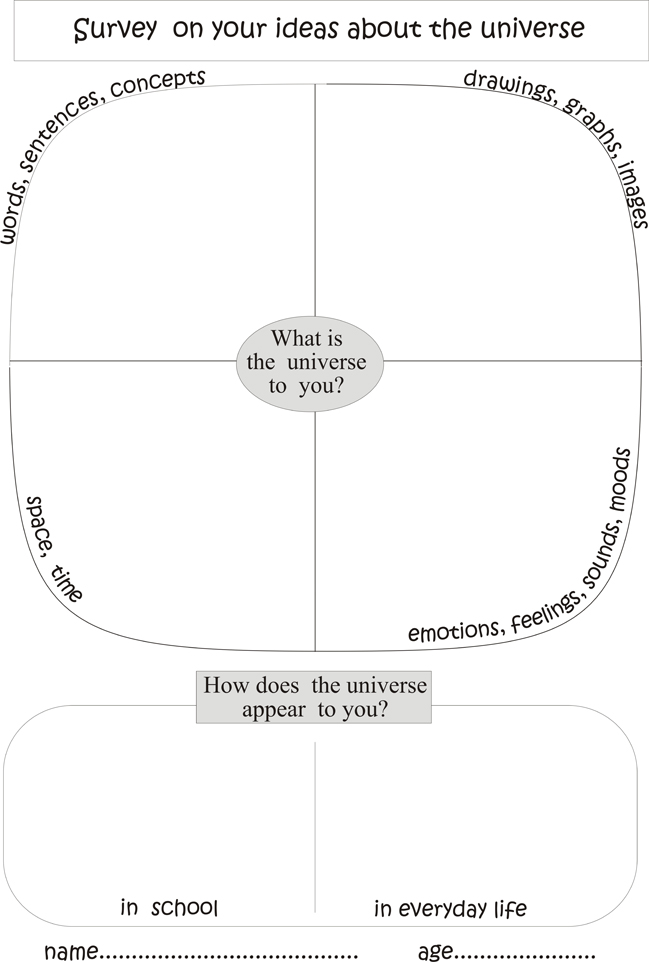
The students’ answers shown in figure 4 are very different and indicate not only the cognitive and expressive skills and styles, but also the students’ social environment.

Many responses (figure 5) refer to stereotypical representations, others reproduce images from telescopes, others are personal elaborations.
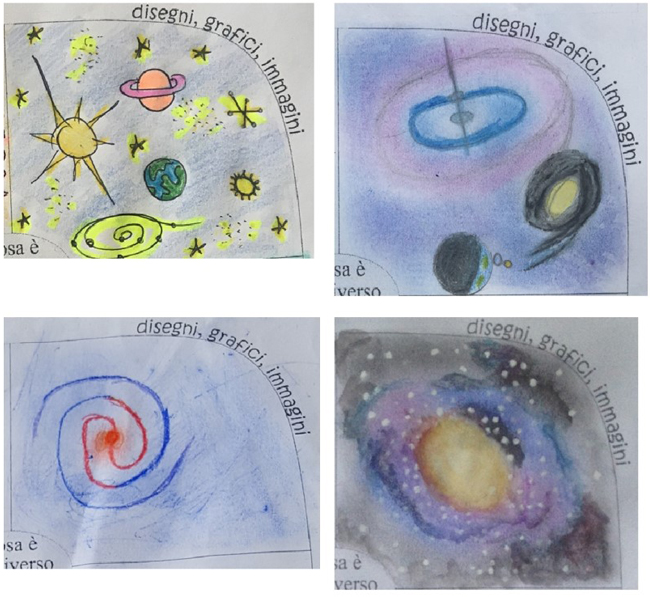
In the answers there are references to symbols, as in figure 6.
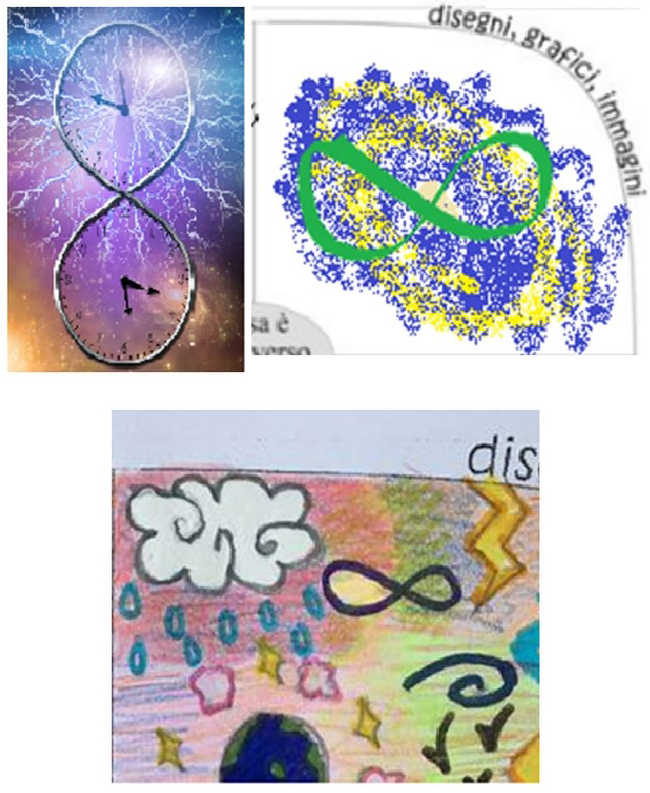
The answers that try to express a position in respect to the universe are very interesting (figure 7).
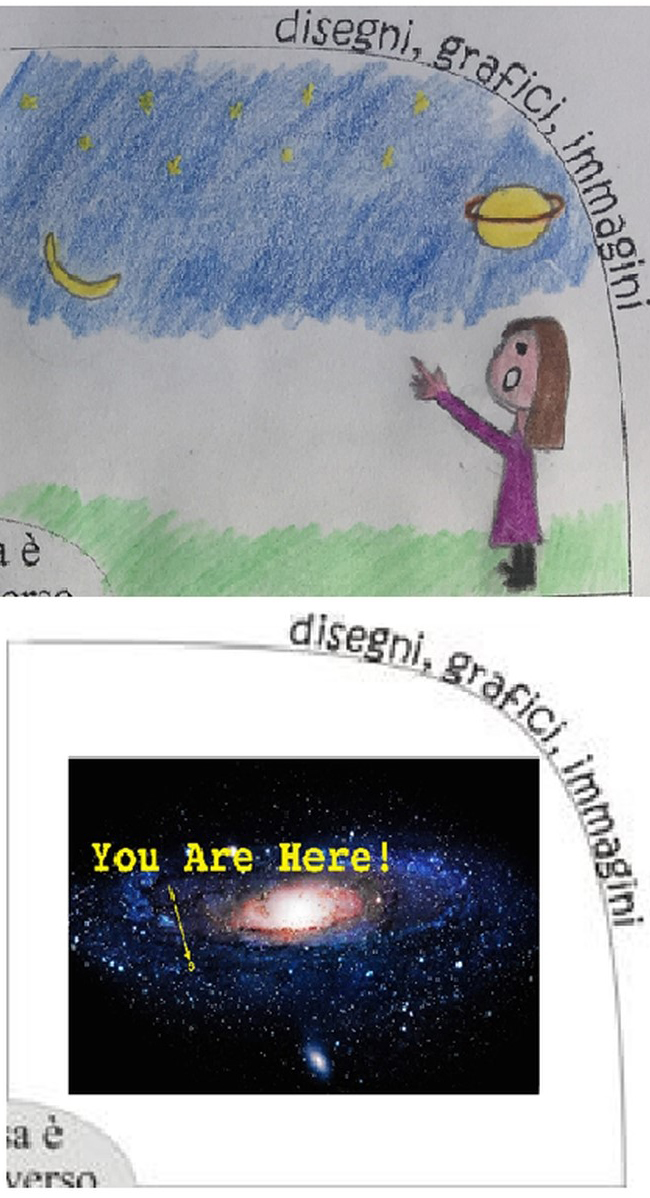
The universe is inside and outside of us, as in figure 8.
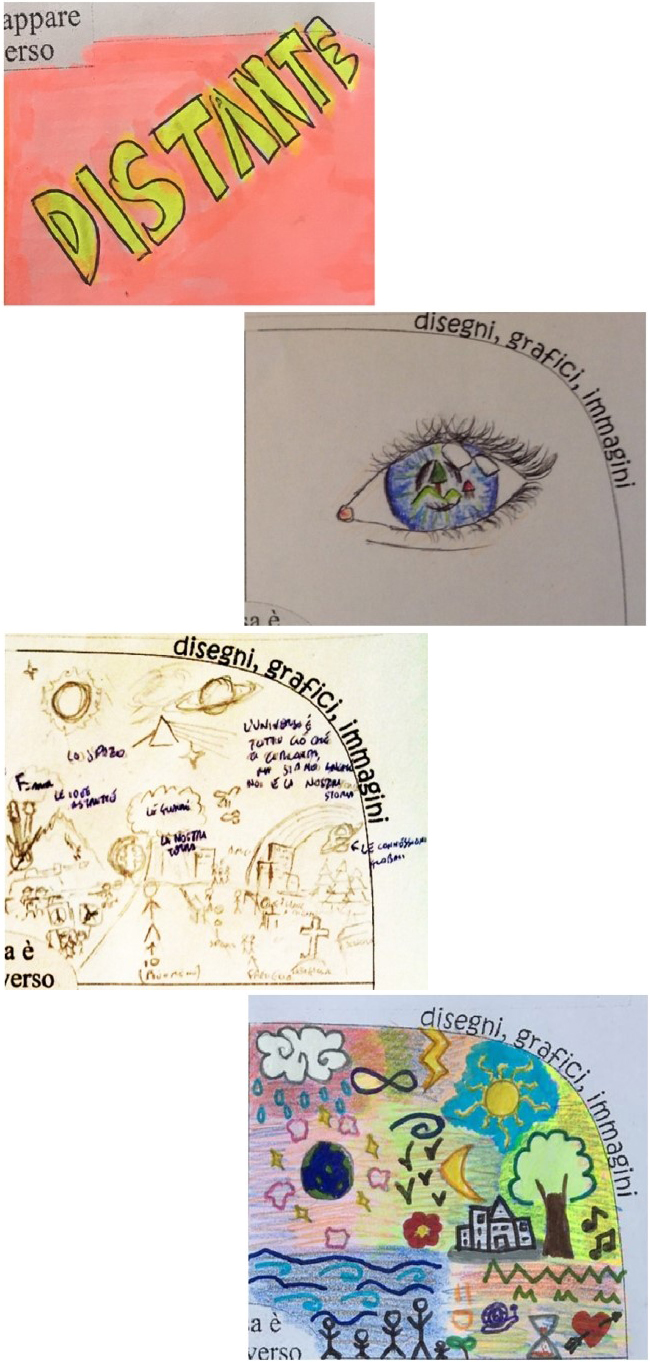
The questionnaire also investigates the universe/school relationship (figures 9, 10).
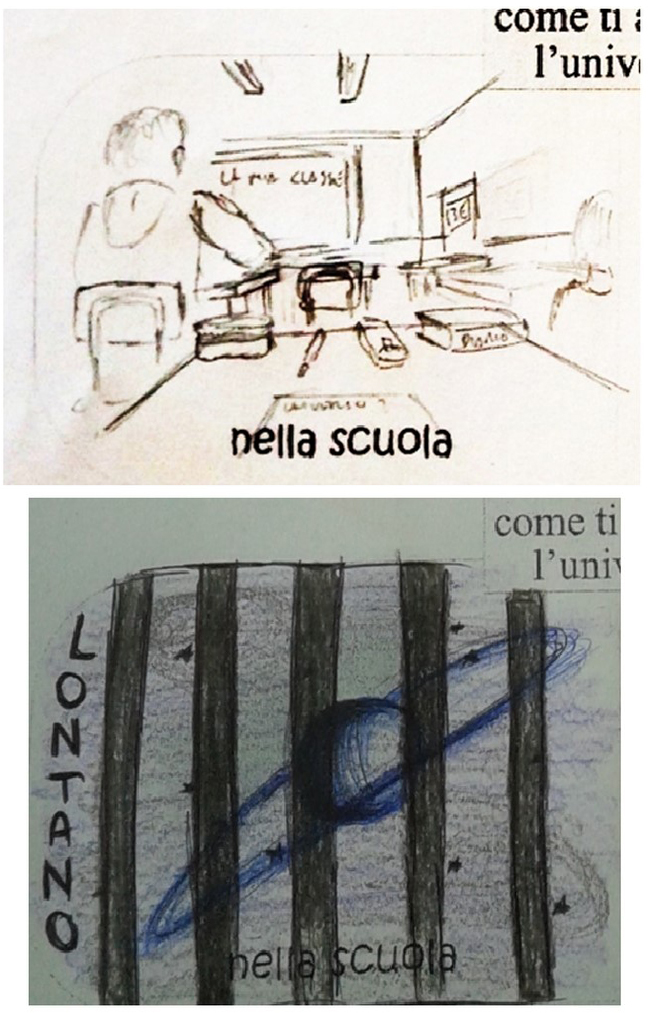
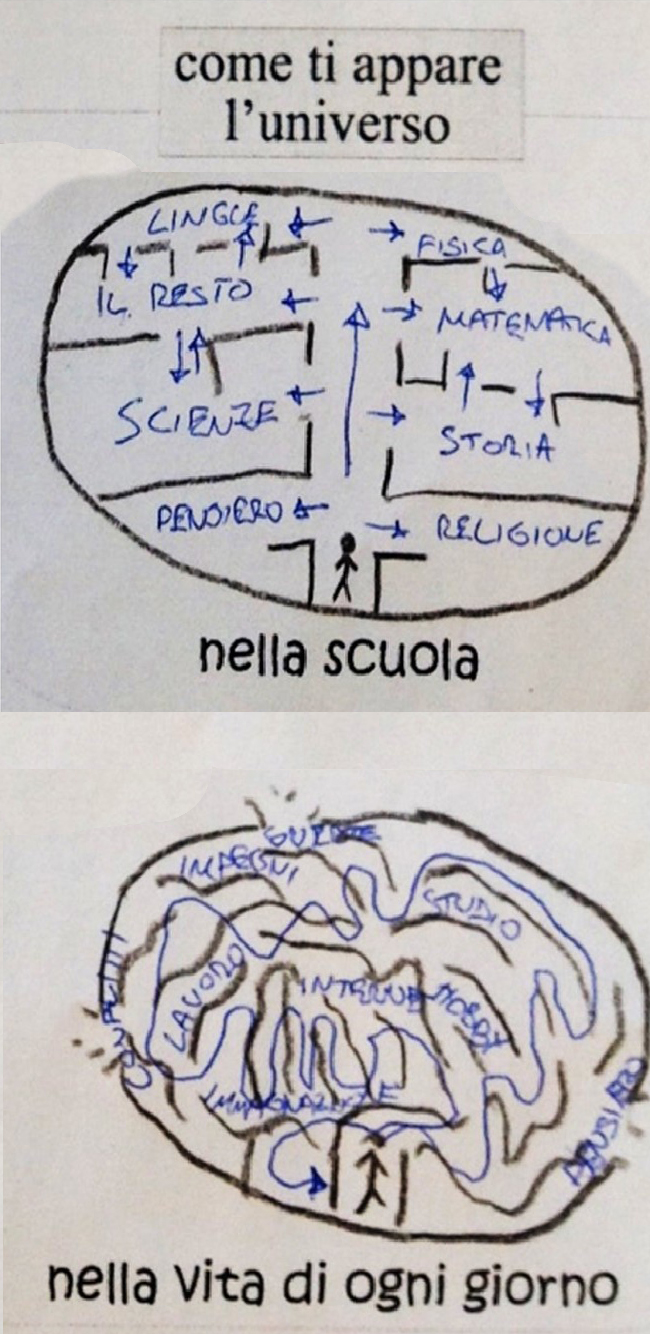
It could be useful to use the questionnaire to compare with other cultures and other educational traditions. Is the organizational rigidity and the fragmentation of knowledge that emerge from many only found in Italian schools?
The analysis of the answers offers a wide variety of interpretations with psychological tools as well. This variety is well suited to gathering the complexity of the topic in relation to students’ perceptions. After completing the questionnaire, they are invited to rework them and to construct, starting from the key words they use, a conceptual map representing their ideas about universe (figure 11).
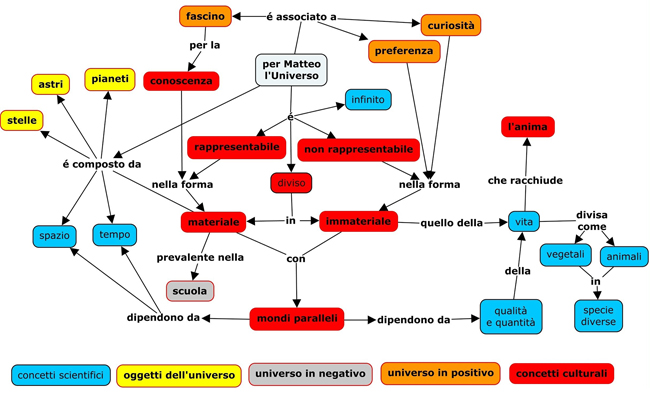
Conceptual maps are used to represent their previously held knowledge about the universe. In fact, the constructivist approach (Novak 1984) shows how using conceptual maps leads to a reflection on learning and helps its consolidation. These reflections can start with a comparison between the words used by each student and the words that were used most by all the interviewees (figure 12).
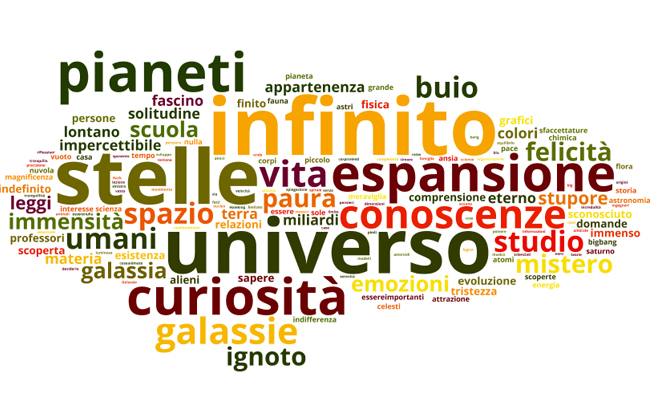
These maps are used to form five groups with similar interests. Each group is assigned a threshold of complexity in the history of the universe: the origins of the universe, the formation of the solar system, life, humans, and modernity. As can be seen from figure 13, the logarithmic scale of time is a guiding tool for locating and interpreting events and jumps of complexity in the history of the universe. The jumps of complexity “can only emerge when the circumstances are right. This includes, in the first place, the availability of suitable building blocks and energy flows and, in the second place, a great many limiting conditions such as temperatures, pressures and radiation. Complexity cannot emerge, or is destroyed, when the circumstances are not right” (Spier 2010, 36).
The groups study the assigned themes using many resources: teachers’ lessons, textbooks, web resources, and especially online lessons from the public course the “Big History Project.” The English subtitles that are provided for each lesson were a great help in overcoming the language barrier and encouraged a deeper comprehension. In the model that has been perfected in the past years working with more classes between the ages of 16 and 17, students work in groups two hours a week, assisted by a different teacher from the same class board. The involvement of teachers of all subjects is very important so that the activities that the students perform in their study of Big History are recognized and appreciated in the final course evaluations of each student. This involvement takes place at the beginning of the activities, through meetings of experienced tutors of Big History with the teachers. The tutors present the main content elaborated by the Big History movement to them, highlighting that in the school curriculum, this content is presented to the students separately at different times and with different aims. They can be tied back together, connecting to each other in order to construct a unitary vision of the history of the universe and of man in it. The tutors then open a discussion with the teachers on the contributions that each subject can give to this vision. Even literature teachers can be involved by identifying “concepts from each of the nine Big History thresholds. Selected works of literature, including plays, poetry, short stories, essays, and novels, are used to exemplify and re-examine these concepts” (Rogoff 2014, 5–6). The students work two hours a week for about twenty hours, followed by their teachers in the classroom and by the tutors remotely through an e-learning platform. They refer to the action research methods (Elliot 1991) in governing the cooperative relationships between tutors, teachers, and students, always keeping in mind that each of the three groups has different motivations and objectives. At the end of this first phase, the groups are mixed using the Jigsaw method, which promotes “autonomy, competence, and social relatedness as posited by self-determination theory of learning” (Hänze 2007). Thus new working groups are formed in which all the knowledge about the history of the universe accrued in the previous phase is present. These groups, with the same schedule and organization as the first phase, must create a product that illustrates the vision of the universe reached through the study of Big History. During the process, the care and thought that the students put into choosing the media with which to share their acquired vision was striking. They produced, or at least designed, documentaries, video clips, e-books, comics, murals, computer applications, and even songs, although essays and conceptual maps were also proposed. Their works were evaluated for the conscious and justified inclusion of the content belonging to the subjects of the school curriculum. In this sense, students are encouraged to find, with the help of their teachers, a convergence of the subjects studied.
In the following year the activity continues with the study of a geographic territory through the lens of Big History. The work is planned following the approach of Little Big History (Quaedeker 2015), which, through the application of the Big History threshold concepts to a specific territory, allows students to bridge the gap between the large scale and universal concepts of Big History and everyday life experiences. Earth sciences are the core of the Little Big History second-year work as they share with Big History a time scale that spans billions of years. The geologic evolution of a territory is also the starting point to study the most recent Big History thresholds, related to human biological and cultural evolution, up to the present day modernity threshold, as “civilization exists by geological consent, subject to change without notice” (Durant 1946).
Each group of students receives the task of studying a specific time span in the history of the selected territory, with time intervals based on a ten-based logarithmic scale. The geologic time and space evolution of the area works as the common thread for the work and facilitates connections between groups.
A pilot test for the second-year approach was focused on Ossola Valley in the Italian Alps, as the complex history of this mountain range offers the best opportunities for diverse applications of Big History. This valley is one of the longest within the Alps and hosts a great geodiversity, which offers the best conditions for the project. In particular, Ossola was chosen because of the following advantages:
-It crosses the entire southern side of the Alps and offers a perfect cross section of the geologic history that led to the formation of this range.
- It hosts several outcrops of rocks much older than the Alps, covering the last 400 million years of Earth’s evolution.
- It was profoundly shaped by glaciers during the last glacial eras, providing a framework on the scale of hundreds of thousands of years.
- It hosts important archeological sites showing the relationships between man and the geologic and geomorphologic evolution on the scale of thousands of years.
- It has been a major quarrying and mining site since the Middle Ages, providing a framework on the scale of hundreds of years till the present.
- It hosts a UNESCO Global Geopark, providing a framework of environmental protection on the scale of years to decades.
Two other specific aspects of Ossola Valley are an important plus for the application of Big History. Firstly, Candoglia and other minor quarries in the valley are the places from which marble was taken for the construction of the renowned Milan Cathedral and other monuments, thus providing an important link with history and the arts. Secondly, the valley is crossed by the “Frontiera Nord,” a fortified line built at the beginning of the twentieth century as a defensive system with the beginning of World War I in sight.
The pragmatic approach to the second-year work is enhanced by a preliminary guided excursion to the selected Little Big History area focused on the close relationship between geological, biological, and cultural evolution and thresholds.
The result of the second-year work is the creation, by collaborative work among groups, of a conceptual model of the complex space- and time-based network of relationships that permeates the studied territory. Thresholds fade into a more comprehensive view that enables students to read the territory with modern eyes where geological, biological, and cultural aspects are closely interrelated. As factual evidence of the newly acquired competence, students elaborate a final product (a smartphone app in the pilot study on the Ossola Valley) for the dissemination and divulgation of their work.
The ModelIn Italy there are many attempts underway to adapt educational institutions to the changes in the collective consciousness brought about by the evolution of knowledge and technology. They are fragmented but widespread, relying on the initiative of individual teachers. Among these, the experiments with Big History, despite still being in the pilot stage and thus not having been able to make use of external evaluations, are very promising. The Big History movement is still little known in Italy, and these trials have spread awareness of it through pedagogical journals (Codetta 2017, 2018). The experiments in introducing the Big History approach during the final two years of secondary school in Italy have provided an abundance of content, encouragement, and methodological indications. Thus it was possible to identify a model that can be adapted for many secondary schools.
- The model does not necessitate modifying the school curricula, which dictates approximately one thousand hours of lessons annually, divided between twelve or more subjects. It requires dedicating to the study of Big History only eighty hours spread out over two years for students ages 16–17.
- To introduce Big History in secondary schools, a tutor experienced in Big History is needed. The tutor proposes to teachers a reflection on the contribution that the subjects they teach can make to the construction of a unitary vision of the universe and its history. In this interdisciplinary activity, all the disciplines of the school curriculum are called together to converge on a single objective.
-From this reflection comes a two-year project in which the students, divided into working groups, conduct investigations into the materials elaborated by the Big History movement. The surveys are carried out by consulting the knowledge platforms on the web and, in particular, courses such as the “Big History Project.”
-The students’ research takes place during the school day for two hours a week. All the teachers of the grade are involved in rotation. Their purpose is to assist the working groups, leaving the students to lead the research, as well as observing the group dynamics of the students through observation charts.
-The course begins with a questionnaire about the students’ preexisting ideas about the universe. Their answers are used to identify the words that students associate with the universe. They also help in the formation of groups of students with similar interests, and finally they serve as a tool for reflection through the development of conceptual maps.
-The tutor assists teachers and students remotely through an e-learning platform, comments on the journals turned in weekly by the working groups, and encourages the convergence of the disciplines to connect events of the history of the universe that are usually studied separately.
-At the end of the first year, through appropriate shuffling of the initial groups, all students must become familiar with the characteristics of the main complexity thresholds in the history of the universe and of the conditions that caused them to emerge.
-The products created by the students at the end of the first year—documentaries, video clips, e-books, comics, murals, computer applications, concept maps, reports—are evaluated mainly on the presence of the disciplinary contents incorporated in the products and how the students connect them.
-In the second year, students use the same work methods, enriched by educational field trips. They explore a geographic territory through the lens of Big History. In many parts of Italy, it is possible to directly observe archaeological, geological, and historical finds that tell the stories of at least half a billion years (Alvarez 2009).
-At the end of the course, the students reflect on the conceptual map of the universe that they created two years before and identify new concepts acquired during their research.
This experience shows that the convergence of multiple subjects in dealing with a complex topic such as Big History generates a highly interactive dynamic among the students in which the determining factor is digital technology. The students create different products, some of which stand out for their nearly professional quality, such as a documentary and an Android app. During the preliminary studies and product creation, a learning process is generated that brings out human qualities that cannot be substituted: creativity, adaptability, inventiveness, the ability to relate to others. In particular, the eight key competences recommended by the European Community are promoted (Enestam 2006): Communication in the mother tongue, communication in foreign languages; mathematical competence and basic competences in science and technology, digital competence, learning to learn, social and civic competences, sense of initiative and entrepreneurship, and cultural awareness and expression.